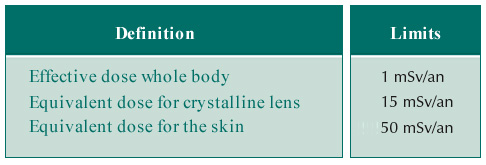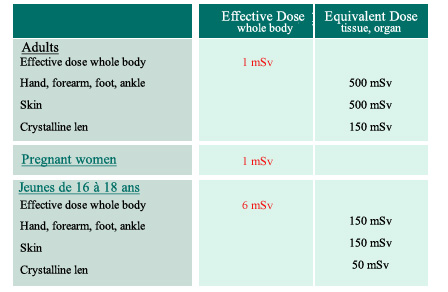Applying the precautionary principle and setting cautious limits

Annual exposure limits beyond medicine and natural radioactivity
These annual limits for exposure of the population are parts of the public health code. These limits apply to the total effective dose or equivalent received outside natural radioactivity and medicine, including those resulting from nuclear activities. The maximum permissible dose of 1 mSv per year represents approximately 40% of natural exposure. (For the skin, it is the average dose per cm2 of skin, to consider).
© ASN
French regulations set at 1 mSv (millisievert) per year maximum admissible effective dose resulting from human activities outside the natural radioactivity and expositions for medical reasons. This is a « whole body dose« . For exposures of an organ or tissue, equivalent doses are considered. For instance, he equivalent dose limits for the crystalline lens and the skin are set respectively to 15 mSv / year and 50 mSv / year.
The limit of 1 mSv / year is for the general public. It compares with the average exposure (outside medical and natural radioactivity) which was of 0.060 mSv / year in France, where exposure to nuclear that concerns the public represents only a part. For people who work with ionizing radiation, the limit is 100 mSv for a set of 5 consecutive years, where the maximum for one year must not exceed 50 mSv.
These limits apply to the total effective dose (or total equivalent dose) received by “ordinary” individuals during a year. The same goes for total equivalent doses. Their surpassing is unacceptable in principle. These limits, however, lend themselves to some confusion. The fact that the natural and medical exposures are excluded is generally forgotten or omitted.
In a developped european country like France, the French population is exposed each yar to an averge effective dose of 3.7 mSv per capita. These 3.7 mSv are divided into 2.5 mSv of natural radioactivity, 1.1 mSv of medical origin and 0.06 mSv of radiation linked to other human activities including nuclear.
The limit of 1 mSv per year might seem excessive, compared with 0.06 mSv due to human activities once ruled out the medical part and even more to 0.002 mSv for the impact of a nuclear power plant. A dose of 1 mSv is considered as a very low radiation dose.
The ICRP (International Commission on Radiological Protection) evaluates as follows its effects by applying the no-threshold linear model : 1 mSv exposition would triggers up to 50 fatal cancers, 10 treatable cancers and 13 genetic diseases per million. These figures compare with the 250,000 cancers that will affect one day, all causes merged, this million people

Annual exposure limits for workers
Annual exposure limits for people exposed to radiation because of their activity, particularly nuclear workers and staff of nuclear medicine. In the case of pregnant women, it would be the exposure of the unborn child. Exemptions justified are allowed in some areas of work and for a limited period. They require a special permit. These special exposures must not exceed two times the legal annual exposure limit.
© ASN (Source)
On the other hand, exposure to radiation of natural and medical origin varies considerably from person to person. These variations, especially because of diagnoses and medical treatments, blithely exceed the limit for the third leading cause of exposure… If one applied a limit of 1 mSv to these two causes, we could not undergo a scan, we should abandon aircraft, mountain climbing, avoid living in Brittany or in Corsica.
The cells of our body do not differentiate between rays of a natural or medical origin and that of a nuclear power plant. If fluctuations in the exposure of a person to person exceed 1 mSv because of habitat or medical diagnostics and treatments that prolong our lives, it seems illusory to reduce an already low limit since the third source exposure is minor in comparison. The limit makes sense only if very low doses trigger cancers: dose reduction of the third type then remove some cancers. But the effect of low doses is highly uncertain and it is quite possible that they have no effect. However because of the uncertainty on the low dose effects, one applies the precautionary principle.
In the case of a major accident : Apply the principle of limitation
Finally, one must provide exceptional measures for radioprotection of the population in case of accident or radiological emergency. Actions and counter measures are implemented according to the nature and extent of exposure. In the case of nuclear accidents, intervention levels expressed in terms of doses are used as benchmarks for governments to decide on a case by case, the actions to put in place:
– Sheltering the population in a safe place, if the predicted effective dose exceeds 10 mSv;
– Evacuation, if the predicted effective dose exceeds 50 mSv;
– Administration of stable iodine, when the thyroid dose is likely to exceed 100 mSv
Other articles on the subject « Radioprotection »
Radioprotection principles
Applying common sense rules according to radiation nature The need for protection from radiation [...]
Gamma Radioprotection
A penetrative radiation more difficult to absorb In the case of ingestion of radioactive substanc[...]
Gamma Attenuation
Attenuation of a gamma beam Of the three types of radiations, gamma rays are the most penetrative[...]
Gamma Absorption
Heavy materials for the absorption of gamma rays In terms of radioprotection mitigate gamma rays [...]
Radioprotection neutrons
A rare radiation, dangerous, penetrating, difficult to absorb The neutron radiation is more penet[...]
Radioactive Decontamination
Avoid all contact, ingestion and inhalation One of the tasks of radiation protection is the decon[...]
Justification and optimisation
In medicine, use of radiation must be justified The ‘Justification and Optimization » princ[...]
Reglementations and controls
Strict regulations for an efficient radioprotection Radioprotection has a long history. Its princ[...]
Actors in radioprotection
The actors and the basics of radioprotection regulations The rules of radiation protection are no[...]